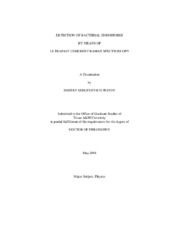| dc.description.abstract | This work is devoted to formulation and development of a laser spectroscopic technique
for rapid detection of biohazards, such as Bacillus anthracis spores. Coherent anti-Stokes
Raman scattering (CARS) is used as an underlying process for active retrieval of
species-specific characteristics of an analyte. Vibrational modes of constituent molecules
are Raman-excited by a pair of ultrashort, femtosecond laser pulses, and then probed
through inelastic scattering of a third, time-delayed laser field.
We first employ the already known time-resolved CARS technique. We apply it
to the spectroscopy of easy-to-handle methanol-water mixtures, and then continue
building our expertise on solutions of dipicolinic acid (DPA) and its salts, which happen
to be marker molecules for bacterial spores. Various acquisition schemes are evaluated,
and the preference is given to multi-channel frequency-resolved detection, when the
whole CARS spectrum is recorded as a function of the probe pulse delay. We
demonstrate a simple detection algorithm that manages to differentiate DPA solution
from common interferents. We investigate experimentally the advantages and
disadvantages of near-resonant probing of the excited molecular coherence, and finally
observe the indicative backscattered CARS signal from DPA and NaDPA powders. The possibility of selective Raman excitation via pulse shaping of the preparation pulses is
also demonstrated.
The analysis of time-resolved CARS experiments on powders and B. subtilis
spores, a harmless surrogate for B. anthracis, facilitates the formulation of a new
approach, where we take full advantage of the multi-channel frequency-resolved
acquisition and spectrally discriminate the Raman-resonant CARS signal from the
background due to other instantaneous four-wave mixing (FWM) processes. Using
narrowband probing, we decrease the magnitude of the nonresonant FWM, which is
further suppressed by the timing of the laser pulses. The devised technique, referred to as
hybrid CARS, leads to a single-shot detection of as few as 104 bacterial spores, bringing
CARS spectroscopy to the forefront of potential candidates for real-time biohazard
detection. It also gives promise to many other applications of CARS, hindered so far by
the presence of the overwhelming nonresonant FWM background, mentioned above. | en |


